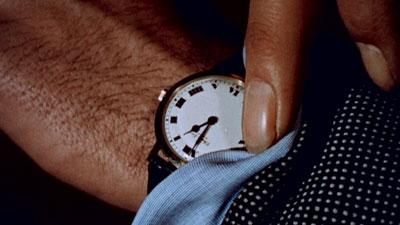This weekend LACMA added eight new works to its collection through its annual Collectors Committee events. All week on Unframed our curators will be highlighting the objects just acquired.

Christian Marclay, still from The Clock, 2010, gift of the 2011 Collectors Committee, © Christian Marclay, photo courtesy Paula Cooper Gallery, New York
Born in San Rafael, California in 1955, Christian Marclay grew up in Geneva, Switzerland. He received his BFA from Massachusetts College of Art in 1980, and currently resides in London and New York City. Working in sound, sculpture, performance, video, and other time-based media, Marclay began manipulating gramophone records and creating time-based works using loops, skips, and scratches on turntables as musical instruments in the 1970s.

Christian Marclay, still from The Clock, 2010, gift of the 2011 Collectors Committee, © Christian Marclay, photo courtesy Paula Cooper Gallery, New York
The Clock, a 24-hour single-channel montage, is constructed out of moments in cinema and television history depicting the passage of time; in other words, scenes in which all manner of clocks and reference to time appear. The Clock weaves together Marclay’s interests in collage and found visual and aural artifacts with his own roots in live performance.
The edited footage of clocks not only provides cues as to the role of time’s passage in the appropriated film narrative, but also serves as a functioning timepiece that marks the exact time in real time for the viewer. When one sees The Clock at 1:17 pm, for example, the action (or inaction) in the clip will be taking place at the same moment. Screened in a cinematic setting, it retains the rhythmic pulsations and tonal shifts typical of Marclay’s sound works but also plays with the viewer’s sense of expectation, casting time as a multifaceted protagonist and creating a conflation of tensions à propos the layered tempos of contemporary life.

Christian Marclay, still from The Clock, 2010, gift of the 2011 Collectors Committee, © Christian Marclay, photo courtesy Paula Cooper Gallery, New York
Marclay follows a long trajectory of artists interested in the history of cinema and the ways in which its footage or grammar can be appropriated and recontextualized. Since the dawning of the medium, experimental and documentary filmmakers have used found or appropriated footage, such as in the collage techniques of Dadaism, Surrealism, and Constructivism, among other historical avant-gardes. An important, albeit much shorter, precedent to Marclay’s The Clock is Bruce Conner’s A Movie (1958), an experimental film which edits together clips from disparate sources, from stag films to sports footage to mainstream melodramas, to create a meta-film that throws out all rules of linearity and narrative progression. Similarly, The Clock causes the viewer to ruminate on what David Velasco, writing for Artforum in February 2011, calls a film or television show’s “temporal grammar” in the way that Marclay “string(s) together this panoply of irrational times according to a rational tempo, [making] salient the idiosyncrasies of movie time.” Additionally, The Clock pays homage to Andy Warhol’s eight-hour film, Empire (1964), which tracks the flickering floodlights of the Empire State Building from sunset to near total darkness around 2 am. It also recalls Swiss duo Peter Fischli and David Weiss’s signature film The Way Things Go (1987), in which a Rube Goldberg device performs a very simple task via a series of chain reactions in 29 minutes.

Christian Marclay, still from The Clock, 2010, gift of the 2011 Collectors Committee, © Christian Marclay, photo courtesy Paula Cooper Gallery, New York
The Clock’s presence at LACMA speaks directly to the institution’s interest in the intersections of contemporary art and cinema. It will be screened in LACMA’s Bing Theater in early May for its West Coast premiere, and in the galleries thereafter—all before its celebratory screening at the Venice Biennale this June.
Christine Y. Kim, Associate Curator, Contemporary Art



